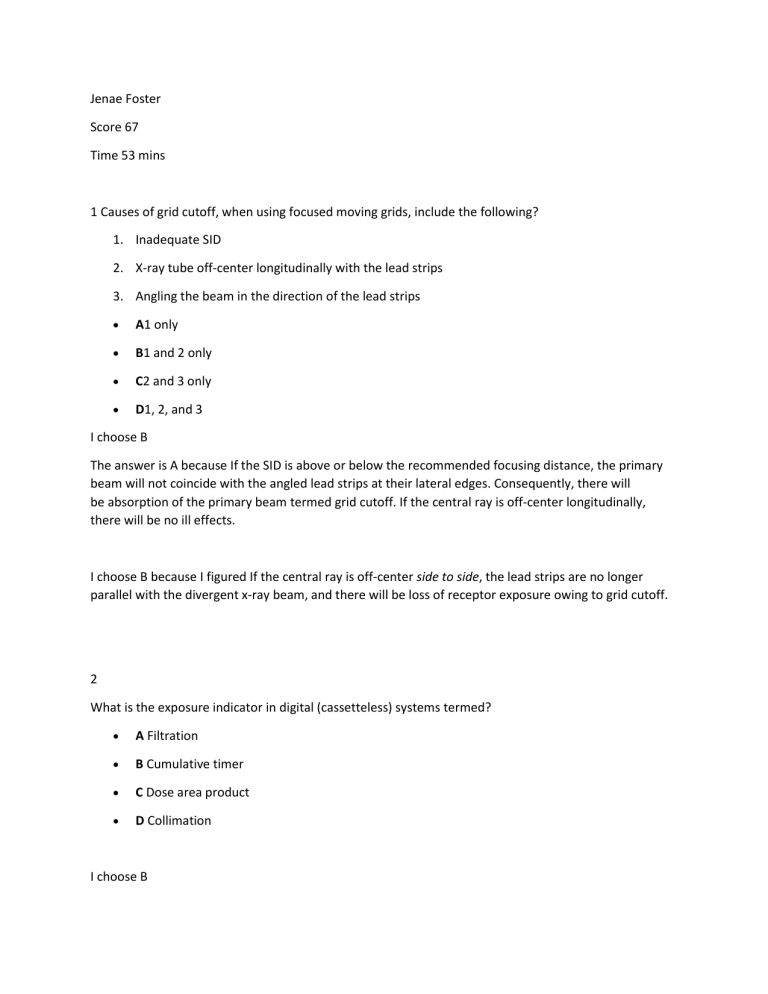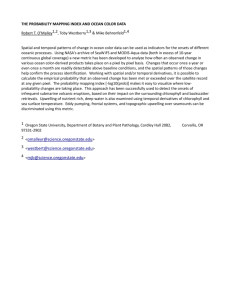
Jenae Foster Score 67 Time 53 mins 1 Causes of grid cutoff, when using focused moving grids, include the following? 1. Inadequate SID 2. X-ray tube off-center longitudinally with the lead strips 3. Angling the beam in the direction of the lead strips A1 only B1 and 2 only C2 and 3 only D1, 2, and 3 I choose B The answer is A because If the SID is above or below the recommended focusing distance, the primary beam will not coincide with the angled lead strips at their lateral edges. Consequently, there will be absorption of the primary beam termed grid cutoff. If the central ray is off-center longitudinally, there will be no ill effects. I choose B because I figured If the central ray is off-center side to side, the lead strips are no longer parallel with the divergent x-ray beam, and there will be loss of receptor exposure owing to grid cutoff. 2 What is the exposure indicator in digital (cassetteless) systems termed? A Filtration B Cumulative timer C Dose area product D Collimation I choose B The answer is C because Effective radiation dose is related to tissue radiation dose and to the volume of tissue exposed. The overall stochastic risk to a patient depends on effective radiation dose. I choose B because I figured that the when the cumulative timer operates, the time accumulation starts, when there is power failure or the startup signal disappears, it automatically saves the time accumulation of the last time. But now I know Dose area product (DAP) may be a better indicator of radiation risk because its quantity reflects not only the dose but also the volume of tissue that is exposed. 3 Requirements for a tilting x-ray table to be used for fluoroscopy are A tilting 30° to the foot side and 30° to the head side. B tilting 90° to the foot side and 90° to the head side. C tilting 90° to the foot side and 30° to the head side. D tilting 30° to the foot side and 90° to the head side. I choose D The answer is C because Requirements for fluoroscopy table tilt are 90° to the foot side and 30° to the head side. For safety reasons, if the table were to tilt more than 30° to the head side, the patient could potentially fall off the table resulting in injury. I choose D because I thought it was because Requirements for fluoroscopy table tilt are 30° to the foot side and 90° to the head side. The foot end of the table has a detachable foot stand that is used when the table will be tilted, which provides stability so the patient does not slide off of the table 4 When using an image intensifier’s magnification mode (select the three that apply) A the focal point moves further from the output phosphor B spatial resolution decreases C patient dose decreases D smaller structures are more visible E a larger portion of the input phosphor is used F the charge on the electrostatic focusing lenses is increased I choose F, A, B The answer is A, D, F because When the image intensifier’s magnification mode is used the charge on the electrostatic focusing lenses is increased; this decreases the size area used on the input phosphor and moves the focal point closer to the input phosphor (farther from the output phosphor). I choose F,D,A because I know that the when the focal point is moved further from the output the phosphor it decreases the size area. When a magnified image having better resolution and demonstrating smaller anatomic structures 5 How do changes in pixel density and pixel pitch impact spatial resolution? A Increased pixel density increases spatial resolution; decreased pixel pitch decreases spatial resolution. B Increased pixel density decreases spatial resolution; decreased pixel pitch increases spatial resolution. C Increased pixel density decreases spatial resolution; increased pixel pitch increases spatial resolution. D Increased pixel density increases spatial resolution; decreased pixel pitch increases spatial resolution I choose C The answer D because pixel density refers to the number of pixels in a given area; pixel density is measured in pixels per inch, or PPI. Pixel pitch is the distance between the center of one pixel to the center of an adjacent pixel. I choose C because I failed to recall that it is an increase and not a decrease in spatial resolution but I now realize that more pixels contribute to better image quality, and the smaller a pixel is, the more pixels can fit into a given area. Therefore, lower pixel pitch and higher pixel density will both result in increased spatial resolution.




